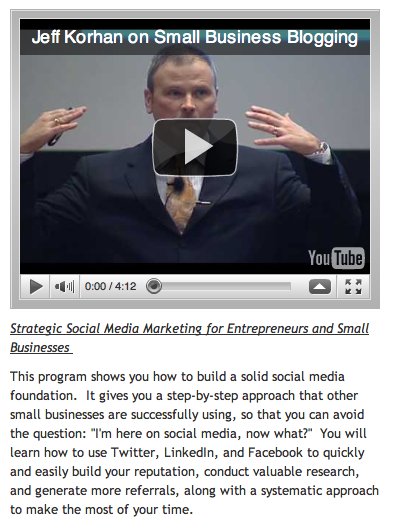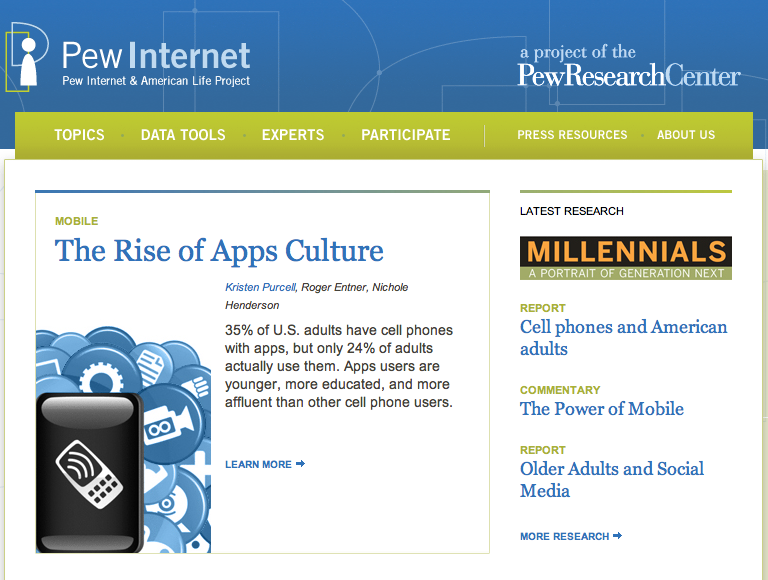 Are your blog posts just “okay”? Want to make them great? If so, keep reading.
Are your blog posts just “okay”? Want to make them great? If so, keep reading.
A great blog post respects the needs of three distinct entities. It educates and informs your audience (your subscribers and visitors), optimizes for the search engines and sufficiently energizes you so that you do a good job creating it.
Every blog post should address the following five components to ensure it hits the mark for your audience, the search engines and you.
#1: Has an Engaging Title
The title is arguably the most important element of any post. Engaging titles that spark curiosity are more likely to be clicked. When this is combined with strategic keywords that affirm the topic of the post, you have a winner.
Tim Ferris recently wrote a post on the art and science of headlines to increase the click-through rate. The idea is simply to generate curiosity, such as Why Are You Single? Perhaps It's the Choice Effect. You're wondering what the Choice Effect is all about, aren't you?
Many of us don't have Tim's fan base, so we need to develop a catchy title that also includes keywords that will get indexed by Google. Brian Clark with Copyblogger does an excellent job of this. One of his generally accepted SEO copywriting tips is to place these keywords near the front of the title.
You should occasionally test your titles to determine what resonates most with your audience. I've personally found that titles that respond to a specific need, such as How Often Should I Blog?, will result in higher traffic with my targeted readers than those that are deep and thought-provoking.
#2: Offers Easy to Consume Content
When you organize your content so that it's easily consumed, you tap into a secret of blogging. The more readily your content is assimilated in the minds of your readers, the more favorably it's received—and remembered.
Here are some ways to accomplish this.
- Blog for Your Audience: As you develop your blogging style, always consider the needs of your audience. My audience is the same as that of Social Media Examiner—business professionals and marketers. They expect me to get to the point quickly and avoid technical jargon.
- Learn to Write in AP Style: If you scan any news source, you'll notice the paragraphs are short—only a few sentences. This is one of the hallmarks of Associated Press (AP) style of writing, which many journalists consider to be the standard. These guidelines will give your posts a professional appearance and make them easier to consume.
- Use Subheadings: This helps both you and the reader. I tend to write my first draft quickly for flow and readability. Then I go back and organize with subheadings, while also reorganizing and eliminating entire paragraphs so that my readers don't have to.
- Create Lists: Lists are the ultimate organizing tool, which is why they're frequently retweeted—thereby attracting valuable links back to your blog.
- Use Italics and Bold Text for Emphasis: If someone reads your blog post word for word, it's usually after skimming it first. Help readers do both by emphasizing key points with italics, bold text and, with care, all caps.
#3: Mixes Content Types
Delivering great content requires a mix of qualities that keeps your readers coming back for more. The key isn't always the quality of the message, but how it's delivered. Improve how you do this by employing these 5 practices.
- Offer Your Opinions: If you're an expert in your field, then your opinion is relevant. Who do you respect more, the waiter who says everything on the menu is excellent, or the one who looks you in the eye and recommends her favorites (or suggests avoiding some dishes)?
- Use Multimedia: Make it a point to use images, screenshots and video to communicate your message with more punch.


These contextual forms of communication enhance your message while also breaking up the text to improve the appearance of your post.
- Link to Your Research: Data has greater credibility when it comes from a reputable source, such as the Pew Research Center. A link to that source raises your credibility by showing you've done your homework.

Data from respected sources such as the Pew Research Center will validate your perspective.

Discover Proven Marketing Strategies and Tips
Want to go even deeper with your marketing? Check out the Social Media Marketing Podcast! Publishing weekly since 2012, the Social Media Marketing Podcast helps you navigate the constantly changing marketing jungle, with expert interviews from marketing pros.
But don’t let the name fool you. This show is about a lot more than just social media marketing. With over 600 episodes and millions of downloads each year, this show has been a trusted source for marketers for well over a decade.
- Provide Practical Examples: Examples of situations where you've had direct experience are powerful, although it's important to provide details such as names and places to validate that credibility. Just be sure you get the proper permissions first.
- Take Out the Trash: Make the effort to edit out anything that doesn't support your title or enhance your post. Include details to create a mental picture, but leave out anything else that detracts from your story.
#4: Is Search Engine Optimized
Learning search engine optimization (SEO) is a necessary aspect of blogging if you expect to build a sustainable reader base. While SEO can get complicated, you can be very effective by simply tuning into your audience and writing for them. Trust your gut and write for people and SEO will take care of itself.
These are the key elements of SEO that deserve your attention.
Get World-Class Marketing Training — All Year Long!
Are you facing doubt, uncertainty, or overwhelm? The Social Media Marketing Society can help.
Each month, you’ll receive training from trusted marketing experts, covering everything from AI to organic social marketing. When you join, you’ll also get immediate access to:
- A library of 100+ marketing trainings
- A community of like-minded marketers
- Monthly online community meetups
- Relevant news and trends updates
- Excerpts: The excerpt of your post is the brief description included with the return of search results. A well-chosen description encourages click-throughs. If you don't build an excerpt, the first couple of sentences of your post will be used as a default. Get in the habit of summarizing your post in the first couple of sentences.
- Keywords: Learn the common words and phrases being used by your audience. For example, do they use the term entrepreneur or small business? It's a distinction that has to be made so that you can be found when they're searching for your expertise.
- Links: The SEO pros universally agree that inbound links to your blog are vital for achieving a high ranking. How do you get these links? The most reliable way is to write amazing content that people want to link to.
One tip is to link to the keywords (known as anchor text) in your post that are aligned with the words you expect to be used by someone searching for your expertise. The classic mistake is linking to click here instead of more relevant keywords such as small business marketing, or whatever relates to your expertise.
Additionally, you naturally want to link back to your previous posts to encourage your readers to hang around longer. This increases the likelihood they'll respond to a call to action, such as subscribing to your blog or newsletter.
- Tags: Tags are handled differently in every blogging platform. Just be sure to use tags that are relevant to the post you're creating, as well as the audience you're blogging for. Darren Rowse of Problogger suggests no more than a dozen tags for each post to avoid undermining their effectiveness through dilution.
- Categories: Categories obviously help your blog visitors go deeper into the subject matter or topic that interests them most. Google also indexes your categories for the same reason, so choose your categories carefully. You'll note the categories here at Social Media Examiner were intentionally limited to just eight to be relevant now and in the future.
#5: Encourages Interaction and Action
While blogging is indeed a platform for broadcasting, the ultimate objective is to encourage engagement and interaction, namely in the form of comments. Just as an engaged audience gives a speaker feedback on his live presentation, the comments to your blog will do the same.
You can and should learn from every single visitor to your blog by responding and seeking to better understand his/her point of view. The reason for this is that every commenter represents the perspective of many others. The more you learn, the easier it is to focus your efforts on what's most relevant to your audience.
Why else do you want comments? Because comments are social proof that your blog is a happening place. And this encourages more traffic and subscribers to your blog.
To encourage more comments, you may not only have to remind your audience to do so, but show them as well. Write a post on commenting and use your blog as an example.

Show your readers exactly how to comment, and even go a step further to describe how to share your post by retweeting or using the Facebook Like button.
As you begin to engage your audience, you'll want to move them closer to helping you accomplish your blogging objectives. For example, you may ultimately want to sell your ebooks. A preliminary step toward that is to encourage more subscribers to your list. Then when the time is right you can reach out to your list to provide higher-value content that monetizes your blogging efforts.
There is no such thing as a perfect blog post. However, if you follow these recommendations, you'll be sure to enhance your blog for you and your audience, as well as the search engines that work on everyone's behalf.
What do you think? What else makes for a great blog post? Leave your comments in the box below.
Attention Agency Owners, Brand Marketers, and Consultants

Introducing the Marketing Agency Show–our newest podcast designed to explore the struggles of agency marketers.
Join show host and agency owner, Brooke Sellas, as she interviews agency marketers and digs deep into their biggest challenges. Explore topics like navigating rough economic times, leveraging AI, service diversification, client acquisition, and much more.
Just pull up your favorite podcast app, search for Marketing Agency Show and start listening. Or click the button below for more information.

